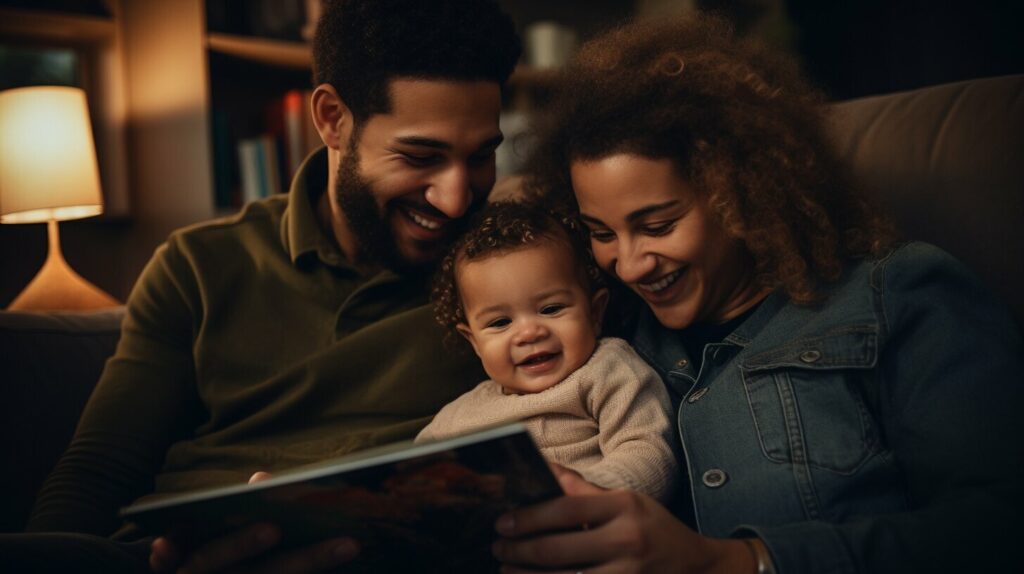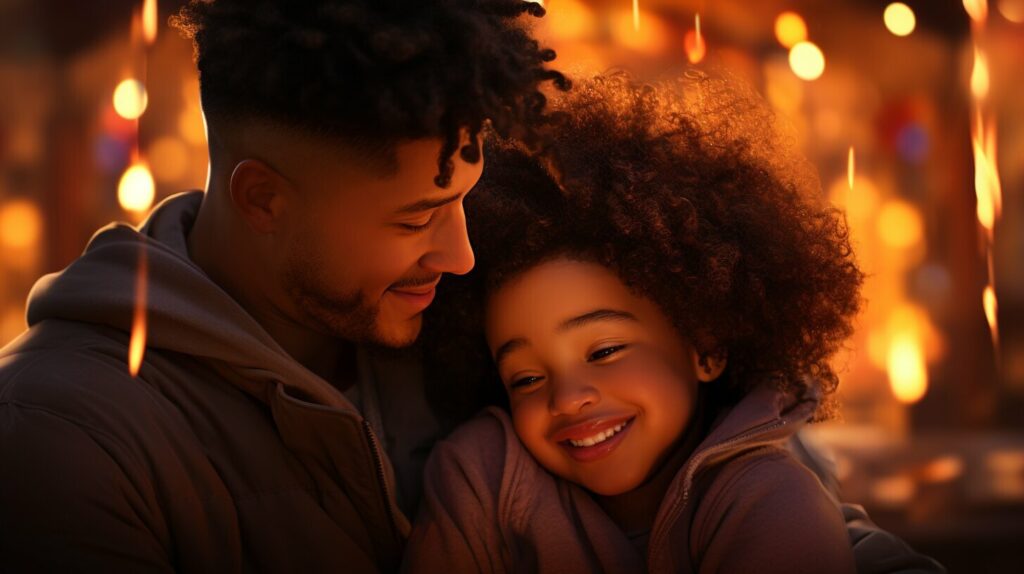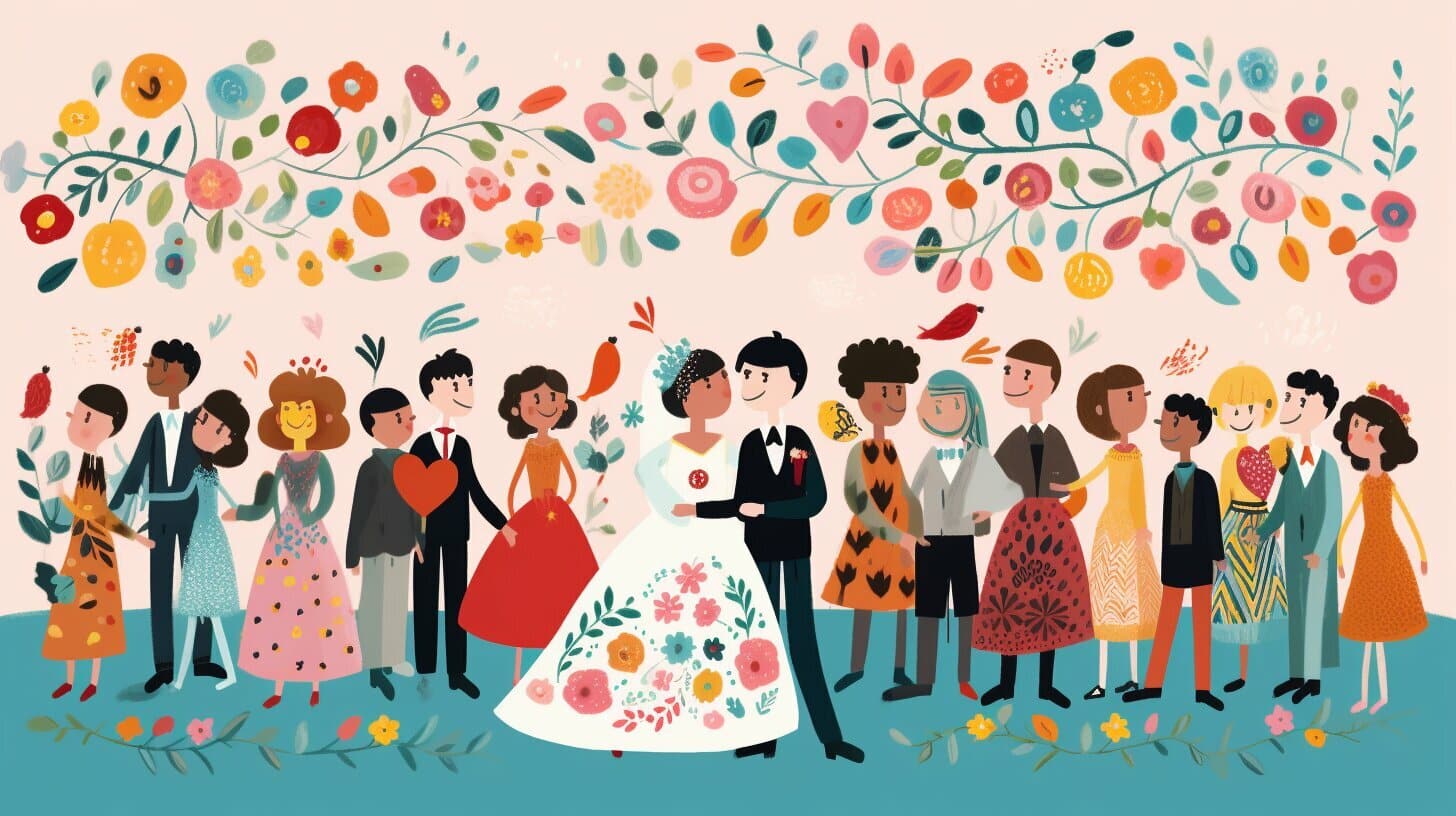Adoption is a beautiful way to grow a family. However, explaining it to a child can be a sensitive and complex topic. It’s important to approach the conversation with patience, empathy, and age-appropriate explanations.
In this section, we will provide tips on how to have a positive conversation about adoption with your child. From understanding adoption basics to answering questions and addressing challenges, we’ll guide you through the process of explaining adoption to a child.
Key Takeaways:
- Adopting a child is a beautiful way to grow a family.
- Explaining adoption to a child can be a sensitive topic.
- Approach the conversation with patience, empathy, and age-appropriate explanations.

Understanding Adoption: Start with the Basics
When explaining adoption to your child, it’s important to start with the basics. You want to provide them with an explanation that they can understand at their age level. Simply put, adoption is the act of becoming a parent to a child who is not biologically yours.
Adoptive parents choose to give a child a forever home and raise them as their own. Families can be formed through different types of adoption, including domestic, international, and foster care adoption. Each type of adoption has its own unique characteristics.
It’s important to emphasize to your child that adoption is a loving act. Birth parents want what’s best for their child, and sometimes that means making the difficult decision to place them with another family. Adoptive parents choose to give a child a safe and loving home, and love them just as much as if they were biologically related.
Remember to use language and explanations that your child can understand. Avoid using technical terms or overcomplicating the conversation. Stick to the basics and let your child lead the conversation with their own questions and thoughts.

Age-Appropriate Discussions: Tailoring the Conversation
When talking to your child about adoption, it is important to consider their age and developmental stage. Tailoring the conversation to be age-appropriate can help ensure that your child understands the information and feels comfortable asking questions.
For younger children, it may be helpful to use simple language and explain adoption in terms of love and family. You can use books or videos that are designed for their age group to help illustrate the concept of adoption.
| Tip | Example |
|---|---|
| Use visual aids | Show your child a family tree with their birth family and adoptive family represented |
| Keep it simple | Explain that they grew in another person’s tummy and their birth family couldn’t take care of them, but your family wanted to love and care for them |
As your child grows and develops a deeper understanding of the world around them, you can provide more detailed explanations about adoption. For example, you can explain legal processes, such as adoption court hearings and paperwork. Make sure to use words that your child can comprehend and avoid overwhelming them with too much information at once.
Remember, every child is different and may have unique needs when it comes to understanding adoption. Be patient, empathetic, and open to answering any questions they may have.

Honesty and Openness: Building Trust
When discussing adoption with your child, it is essential to be honest and open about their adoption story. Honesty builds trust, which is essential in creating a strong bond between parents and children.
Children who are adopted have a unique history and experience, and it is vital to validate their feelings and emotions. When discussing sensitive topics, such as birth parents or the circumstances that led to their adoption, it is essential to approach the conversation with empathy and understanding.
It is natural for children to be curious about their adoption story and ask questions. Answering their questions honestly and age-appropriately can help build trust and promote a positive self-identity. Avoiding or sugarcoating the truth can damage their trust, causing confusion or feelings of betrayal.
Being honest with my daughter about her adoption story has helped us build a stronger bond and has given her the confidence to share her story with others.
It is also helpful to allow your child to express their feelings about their adoption story. Encouraging open communication can help them process their emotions and feel a sense of support and understanding.
Remember that honesty and openness should be ongoing throughout your child’s life. As they grow and develop, new questions and emotions may arise, and it is essential to continue to approach these conversations with honesty, empathy, and support.

Using Books and Resources: Enhancing Understanding
One great way to help your child understand adoption is by using age-appropriate books and resources. Not only can they enhance your child’s understanding of the concept, but they can also help answer any questions they may have. Below are some recommended resources:
- The Mulberry Bird by Anne Braff Brodzinsky: This book explores the different emotions and adventures that come with being adopted.
- Adopted Like Me by Michael C. Watson: Written by an adoptive parent, this book features stories from children of diverse ethnicities and backgrounds.
- A Family is a Family is a Family by Sara O’Leary: This book celebrates the idea that families come in all shapes and sizes, including through adoption.

Other resources you can consider include videos, documentaries, and online forums. Just be sure to preview materials before sharing them with your child to ensure they are appropriate and aligned with your family’s values.
Emphasizing Unconditional Love: Reinforcing Belonging
One of the most important things to remember when explaining adoption to a child is to emphasize the love and belonging they have within the family. While the child may have questions or concerns about their adoption story, it’s crucial to reinforce the fact that adoption does not change the love and bond between the child and their adoptive parents.
There are many ways to show love and support to help the child feel secure in their identity. You can try:
- Telling them how much you love them every day
- Showing affection through hugs, kisses, and snuggles
- Displaying family photos and mementos that celebrate your love and memories together
- Encouraging the child to express their thoughts and emotions openly and without judgment
Remember, adoption is a beautiful and loving way to grow a family. Your child is a cherished and valued member of your family, and they deserve to feel loved and supported no matter what.

Answering Questions: Encouraging Curiosity
Encouraging your child to ask questions about their adoption story is an essential part of helping them understand and accept their unique family dynamic. Creating a safe and open environment where your child feels comfortable expressing their curiosity is crucial. By responding to their questions with honesty and age-appropriate explanations, you can help your child embrace their adoption story with confidence.
When your child asks questions about their adoption, it’s important to listen carefully and respond with empathy. Avoid dismissing or avoiding their questions, as this can make your child feel unsupported and confused. Instead, validate their curiosity and encourage them to express themselves openly.
When answering your child’s questions, it’s helpful to use language and explanations that match their age and developmental stage. For younger children, simple and concise answers are best, while older children may benefit from more detailed explanations.
Remember, it’s okay if you don’t have all the answers. It’s okay to admit when you don’t know something and to seek help from professionals or other adoptive families. Honesty and transparency are critical to building trust and strengthening your relationship with your child.
It’s also important to be sensitive to your child’s emotions when discussing their adoption story. Be prepared for a range of reactions, including sadness, anger, confusion, and curiosity. Offer reassurance and support, and let your child know that it’s okay to feel what they’re feeling.
Encouraging your child to ask questions and express their curiosity about their adoption story is an important way to empower them and help them build a positive narrative about their family. By responding with honesty, empathy, and support, you can foster a strong and healthy parent-child relationship based on trust and understanding.

Celebrating Adoption: Creating Family Traditions
Adoption is a beautiful way to form a family, and it’s important to celebrate it as such. By creating special traditions or events that honor your child’s adoption story, you can reinforce their sense of belonging and pride in their unique identity.
Consider creating an adoption anniversary celebration, where you mark the day the adoption was finalized with a special meal or outing. You could also create a memory scrapbook or photo album that showcases your child’s adoption story, including pictures and mementos from the adoption process.
Another idea is to incorporate elements of your child’s cultural heritage or birth culture into your family traditions. This can help your child feel connected to their roots and proud of their heritage. For example, you could celebrate holidays or festivals from your child’s birth country, or learn to cook traditional foods from their culture.
Remember that celebrating adoption doesn’t have to be limited to big events or special occasions. You can also incorporate small gestures of love and support into your daily routine. Consider writing your child a letter or creating a special keepsake that reminds them of how much they are loved and valued.

By emphasizing the positive aspects of adoption and creating a sense of pride and belonging around your child’s adoption story, you can help them grow up feeling loved, supported, and confident in their identity.
Addressing Challenges: Dealing with Difficult Emotions
While discussing adoption with your child can be a positive experience, it’s important to acknowledge that it can also bring up difficult emotions. Your child may experience feelings of loss, confusion, or identity issues related to their adoption story. As a parent, it’s essential to provide support and guidance through these challenges.
One way to address difficult emotions is to create a safe and non-judgmental environment where your child feels comfortable expressing their feelings. Encourage them to share their thoughts and worries with you, and listen to them without judgement. Reassure them that their feelings are valid and that you are there to support them through any challenges.
It’s important to approach sensitive topics with empathy and understanding. Use age-appropriate language and explanations to help your child understand their adoption story and any associated emotions. You may also consider seeking professional help if needed, such as a therapist or counselor who specializes in adoption-related issues.
Remember that every child’s adoption story is unique, and there is no one-size-fits-all approach to addressing difficult emotions. However, by providing love, support, and empathy, you can help your child navigate any challenges that arise and create a positive and meaningful relationship with their adoption story.

Sharing Their Adoption Story: Empowering the Child
One way to help your child understand and embrace their adoption story is by empowering them to share it with others. Encouraging them to talk about their adoption can help build their confidence, resilience, and self-esteem.
Here are some tips to help your child start sharing their adoption story:
- Start at home: Encourage your child to talk about their adoption with family and close friends. This can help them feel more comfortable and confident sharing their story later on.
- Practice: Role-play with your child and practice sharing their adoption story in different situations. This can help them feel more prepared and confident when the opportunity arises.
- Be positive: Encourage your child to focus on the positive aspects of their story. Help them develop a positive narrative that emphasizes love, care, and belonging.
- Be honest: Remind your child to be honest and factual when sharing their story. Encourage them to answer questions truthfully and with age-appropriate language.

Remember, every child’s adoption story is unique and personal. Empowering your child to share their story can help them embrace their identity and build a sense of pride and belonging.
Support and Community: Connecting with Other Adoptive Families
Connecting with other adoptive families can be a valuable source of support and community for both the parents and child.
Sharing your experiences and learning from others who have gone through similar situations can help you feel less alone and more understood. It can also provide an opportunity for your child to meet and connect with other adoptees, which can be beneficial for their sense of identity and belonging.
Consider joining a local or online support group for adoptive families. Many organizations offer resources and events for adoptive families, such as informative workshops, playgroups, and support meetings.
Some helpful resources for finding adoptive family support groups include:
- The National Adoption Foundation
- The North American Council on Adoptable Children
- The Adoption Exchange Association
Remember, you don’t have to navigate the journey of adoption alone. Connecting with others who share your experiences can provide much-needed support, guidance, and a sense of community.

Conclusion
Explaining adoption to a child can be both a beautiful and challenging experience. Remember to approach the conversation with empathy, honesty, and love. Keep in mind the importance of considering the child’s age and developmental stage when discussing adoption. Using age-appropriate language and resources can help enhance their understanding and answer any questions they may have.
Reinforce the child’s sense of belonging and unconditional love within the family. Celebrate adoption as a positive aspect of your family’s story. Address any potential challenges or difficult emotions with support and reassurance, and seek professional help if necessary. Encourage the child to share their adoption story and empower them to build a positive narrative about their adoption.
Remember:
- Be patient and open-minded
- Provide age-appropriate explanations
- Encourage questions and curiosity
- Reinforce the child’s sense of belonging and unconditional love
- Celebrate adoption as a positive aspect of your family’s story
- Address challenges with empathy and support
- Empower the child to share their adoption story
- Connect with other adoptive families for support and community
By approaching the topic of adoption with patience and understanding, you can help your child develop a strong sense of identity and a positive outlook on their unique story. Remember to prioritize love, honesty, and support throughout the conversation.

How Can I Teach My Child to Be Grateful for their Adoption?
Teaching children gratitude towards their adoption can be done through open communication and understanding. A parents’ guide to explaining gratitude to children can help navigate this delicate topic. Encourage your child to express their feelings, validate their emotions, and emphasize the significance of their adoption. By fostering an atmosphere of appreciation and encouraging reflection, you can help instill a sense of gratitude in your child for their unique journey.
FAQ
Q: How do I explain adoption to my child?
A: When explaining adoption to your child, it’s important to have a positive and meaningful conversation. You can start by explaining that adopting a child is a beautiful and loving way to grow a family.
Q: How can I start discussing adoption with my child?
A: Start by explaining the concept of adoption in simple terms that your child can understand. Talk about how families can be formed through adoption and emphasize that it is an act of love and care.
Q: How do I tailor the adoption conversation based on my child’s age?
A: It’s important to consider your child’s age when discussing adoption. Adapt the conversation to their developmental stage and use age-appropriate language and explanations.
Q: Why is honesty and openness important when discussing adoption?
A: Being honest and open about your child’s adoption story helps build trust and strengthens the parent-child relationship. Approach sensitive topics with empathy and understanding.
Q: What resources can I use to enhance my child’s understanding of adoption?
A: You can use age-appropriate books, videos, and other resources to help explain adoption to your child. These materials can answer their questions and enhance their understanding.
Q: How can I reinforce my child’s sense of belonging through adoption?
A: Emphasize that adoption does not change the love and bond between your child and their adoptive parents. Show unconditional love and support to help your child feel secure in their identity.
Q: How should I address my child’s questions about adoption?
A: Encourage your child’s curiosity and create a safe and open environment where they can feel comfortable asking questions. Answer their questions honestly and in a way that is age-appropriate.
Q: How can I celebrate adoption as a family?
A: Create special traditions or events that honor your child’s adoption story, such as an adoption anniversary celebration or a memory scrapbook. Emphasize the positive aspects of adoption and its unique qualities.
Q: How can I deal with difficult emotions when discussing adoption?
A: Address any challenges or difficult emotions with empathy, support, and reassurance. Seek professional help if needed.
Q: How can I empower my child to share their adoption story?
A: Help your child develop a positive narrative about their adoption and encourage them to share their story with others. This can help them build resilience and confidence.
Q: How can I connect with other adoptive families for support?
A: Connect with other adoptive families and support groups to share experiences, learn from others, and build a sense of community. There are local and online resources available for finding support networks.






